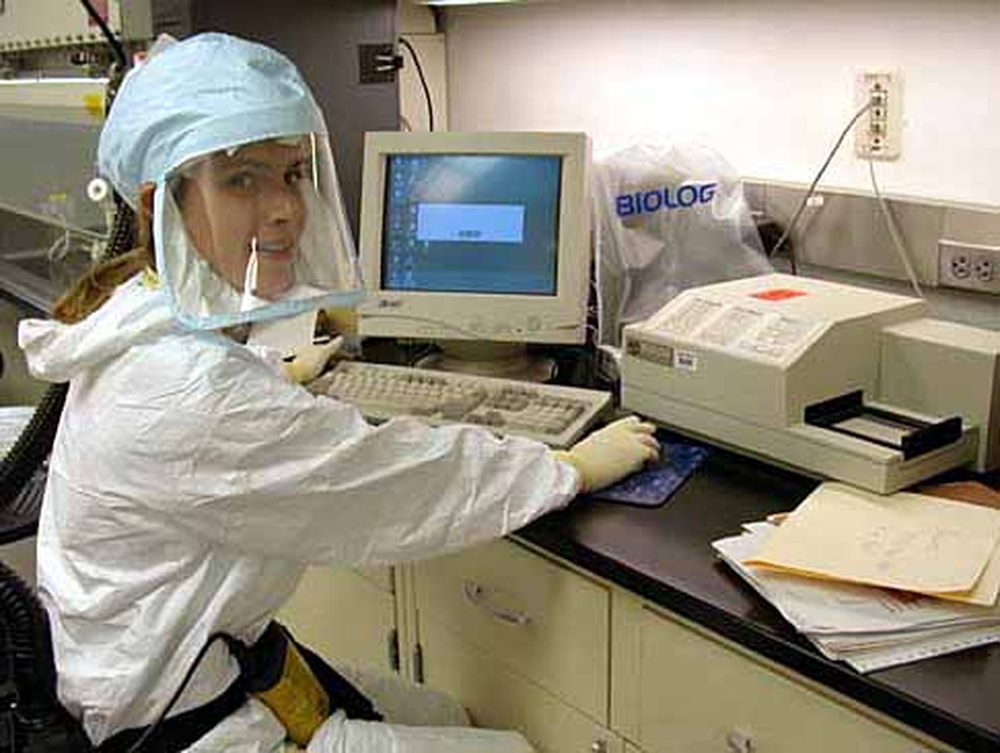Anthrax. When the disease was the first thing on everyone’s mind last October, a team from the Armed Forces Institute of Pathology here was poring over thousands of samples to answer the second: What’s going on?
Only 236 total cases were reported in the United States between 1955 to 1999, said microbiologist Dana Kadavy, who helped lead the AFIP team. The most recent inhalational anthrax fatality was in 1976, when the victim died after handling wool contaminated with anthrax spores. So anthrax normally isn’t seen much in the United States.
All that changed, however, when a newspaper employee in Boca Raton, Fla., died of inhalational anthrax in October 2001. By Nov. 20, almost two dozen confirmed cases of anthrax had been reported, including 11 inhalational cases. In all, five people succumbed to anthrax before the crisis seemed to abate.
Kadavy said anthrax bacteria can infect the skin, digestive tract or lungs, with the suspected infective dose for the lungs being anywhere from 8,000 to 50,000 spores. Anthrax is not transmitted from person to person, she said. Most typically, the disease appears in herbivores such as cattle and sheep. Humans typically contract the bacteria through contact with contaminated animal products.
AFIP staffers were caught in a swirl of public concern. The Defense Department routed requests for help from the Centers for Disease Control and Prevention to the institute. A team of six scientists deployed to CDC’s Atlanta headquarters to conduct tests shortly after the first attacks took place.
Days later, scientists of AFIP’s Biosafety Level 3 lab commenced a weeks-long operation to identify suspected anthrax samples submitted from around metropolitan Washington.
“It was a very exciting, although stressful, time for our microbiology staff,” said Ted Hadfield, Microbiology Division chief in the institute’s Department of Infectious and Parasitic Diseases Pathology.
BSL-3 lab has for years studied organisms that could pose a threat to deployed service members around the globe.
“We’ve been involved in collaborative efforts with other DoD agencies to develop rapid diagnostic tests to support the identification of threat agents, including brucella, tularemia, plague and anthrax, all of which can be developed for biological weapons,” Hadfield said. Because such tests can identify agents quickly, treatment can start before the service member even becomes sick, he noted.
AFIP scientists and support personnel expertly diagnosed over 5,000 environmental and clinical samples of suspected anthrax following the October 2001 attacks, according to Hadfield. The AFIP team performed over 10,000 tests on the samples and confirmed the presence of anthrax in 62 cases.
Kadavy said the numbers could have been far worse. “The (Sen. Thomas) Daschle and (Sen. Patrick) Leahy letters sent to Capitol Hill each contained trillions of ‘weaponized’ spores — potentially equating to 200 million doses,” she said. “The Leahy and Daschle letters were processed alongside approximately 85 million pieces of mail, in sorting facilities found to be grossly contaminated, so the potential for tragedy was great.”
AFIP is a member of the CDC Laboratory Response Network and has a level C lab. As state health labs became overwhelmed with samples to process, CDC turned to AFIP and its microbiology experts to conduct testing in the institute’s BSL-3 laboratory.
Using full protective suits and respiratory systems, the microbiology team used the AFIP-developed polymerase chain reaction assay and three CDC-approved tests to find and confirm the presence of anthrax in the samples, Hadfield said.
“Our staff worked up to 15 hours a day for weeks to keep up with all the samples coming in,” he pointed out.
Staff members processed and cultured materials received from clinical sites within 24 hours. Several thousands of the environmental samples came from federal buildings and post offices. Samples included swabs, ventilation system filters, clothes, newspapers, trash, mail and packages, among others.
AFIP scientists typically wiped a swab on an environmental sample, such as a letter, surface or clothes; wiped the swab on a sterile culture medium; and then heat-shocked the specimen. After eight to 15 hours, scientists could read cultures for cloudiness, which indicates the growth of spore-forming bacteria. Other tests would tell whether the germs were anthrax and, if so, the strain.
“We were very pleased to see that the sensitivity and specificity of our own assays equaled those provided by the CDC,” Hadfield said. “It was a real affirmation of the quality of our scientific work.”
(Christopher C. Kelly is the public affairs director of the Armed Forces Institute of Pathology.)
Story by Christopher C. Kelly, National Guard Bureau
| Date Taken: | 08.26.2002 |
| Date Posted: | 07.04.2025 00:02 |
| Story ID: | 527760 |
| Location: | WASHINGTON, US |
| Web Views: | 1 |
| Downloads: | 0 |
PUBLIC DOMAIN
This work, AFIP Scientists Perform 10,000 Tests to Help Stem Anthrax Crisis, must comply with the restrictions shown on https://www.dvidshub.net/about/copyright.
